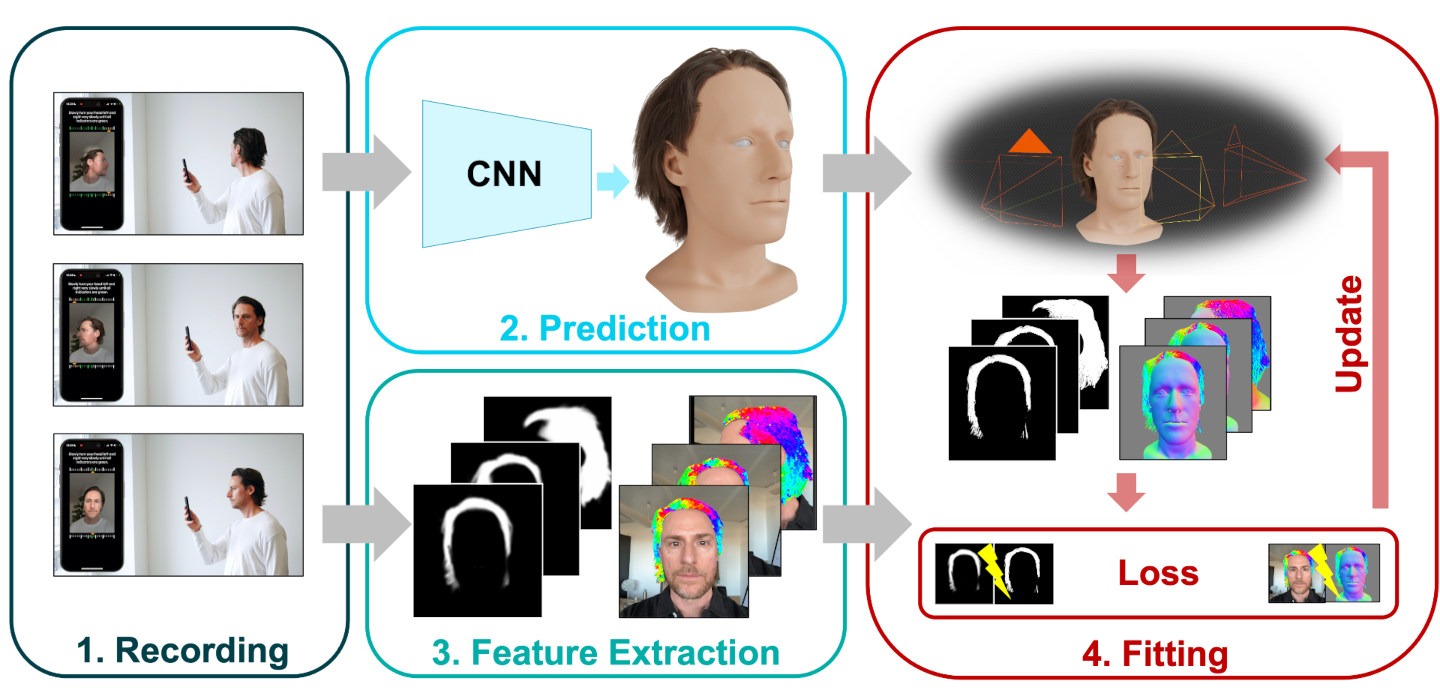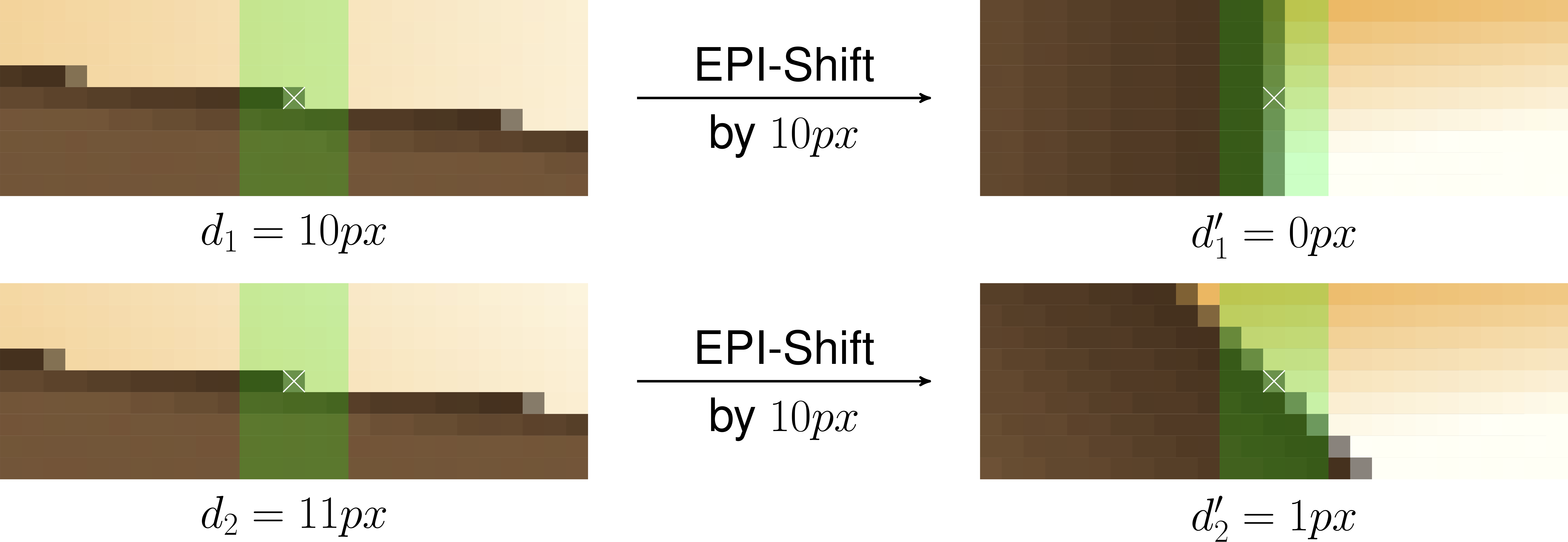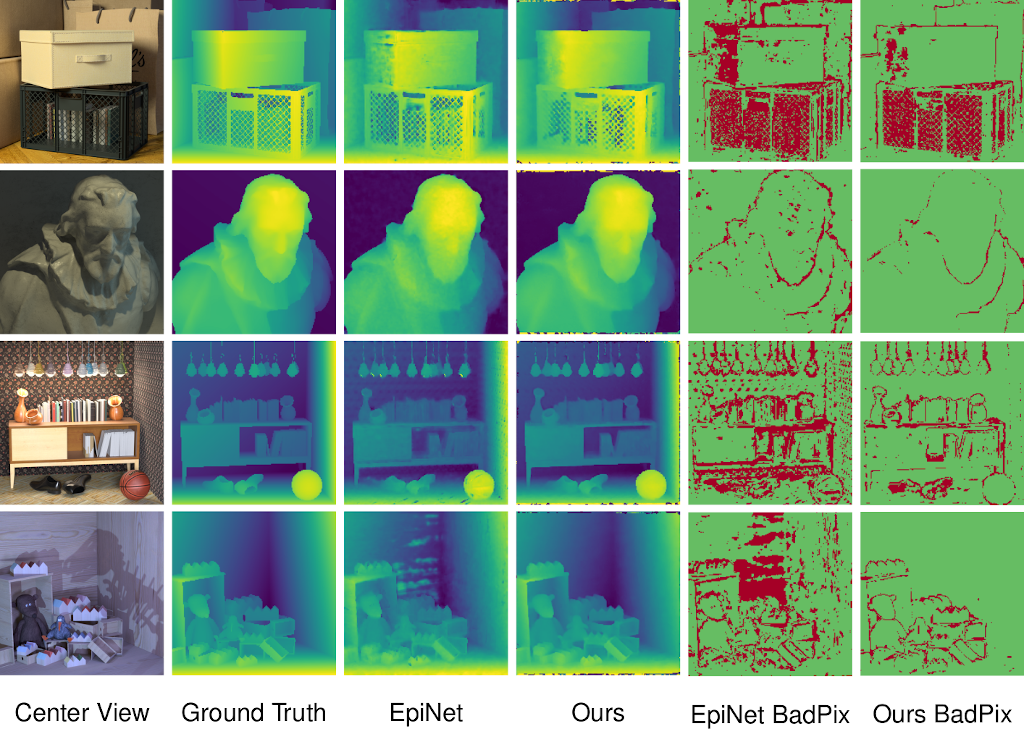August 10, 2025
 This talk was presented by me at SIGGRAPH 2025.
This talk was presented by me at SIGGRAPH 2025.
Abstract
 We propose a novel mobile scanning solution that allows end-users to reconstruct 3D hairstyles with actual per-strand curves from just a phone scan. Using a mixture of deep learning and optimization, we make hair scanning fast and accessible while delivering qualitative assets ready to be used in any 3D software.
We propose a novel mobile scanning solution that allows end-users to reconstruct 3D hairstyles with actual per-strand curves from just a phone scan. Using a mixture of deep learning and optimization, we make hair scanning fast and accessible while delivering qualitative assets ready to be used in any 3D software.
Video
Citation
@inproceedings{grassal2025mobile,
title={A Mobile Scanning Solution to Reconstruct Strand-Based Hairstyles},
author={Grassal, Philip-William and Hormann, Luca and Hamlaoui, Nadia and Leistner, Titus and Ardizzone, Lynton},
booktitle={Proceedings of the Special Interest Group on Computer Graphics and Interactive Techniques Conference Talks},
pages={1--2},
year={2025}
}
July 23, 2024

Abstract
Light fields have emerged as a highly accurate method for depth estimation, known for its precision and robustness against occlusions.
After the decline of consumer-based light field cameras, new industrial and research applications have emerged with very different demands, including the usage of high-resolution wide-baseline camera arrays and the need for a reliable confidence measure.
This thesis responds to these evolving requirements with two main contributions:
First, the introduction of EPI-Shift, a deep learning-based framework for depth estimation from both, small- and wide-baseline light fields.
EPI-Shift combines discrete disparity classification with continuous disparity-offset regression and performs well on wide-baseline light fields, even when trained solely on narrow-baseline data.
The second contribution focuses on multimodal posterior regression in depth estimation, useful for dealing with reflective and semi-transparent surfaces and for uncertainty quantification.
This thesis contributes three deep learning-based approaches for depth posterior regression: UPR, ESE, and DPP.
Each of these methods displays strengths and weaknesses for different applications, evaluated using a novel multimodal light field depth dataset.
Even with the extended applicability to wide-baseline light fields and the enhanced posterior regression capabilities, the performance of the presented methods stays on par with other state-of-the art approaches, marking a significant step towards practicality for today's applications.
Citation
@phdthesis{leistner2024deep,
title={Deep Learning-Based Depth Estimation from Light Fields},
author={Leistner, Titus},
year={2024}
}
June 21, 2022
 This paper was published at CVPR 2022.
Download slides and poster.
This paper was published at CVPR 2022.
Download slides and poster.
Abstract
 Light field applications, especially light field rendering and depth estimation, developed rapidly in recent years. While state-of-the-art light field rendering methods handle semi-transparent and reflective objects well, depth estimation methods either ignore these cases altogether or only deliver a weak performance. We argue that this is due current methods only considering a single "true" depth, even when multiple objects at different depths contributed to the color of a single pixel. Based on the simple idea of outputting a posterior depth distribution instead of only a single estimate, we develop and explore several different deep-learning-based approaches to the problem. Additionally, we contribute the first "multimodal light field depth dataset" that contains the depths of all objects which contribute to the color of a pixel. This allows us to supervise the multimodal depth prediction and also validate all methods by measuring the KL divergence of the predicted posteriors. With our thorough analysis and novel dataset, we aim to start a new line of depth estimation research that overcomes some of the long-standing limitations of this field.
Light field applications, especially light field rendering and depth estimation, developed rapidly in recent years. While state-of-the-art light field rendering methods handle semi-transparent and reflective objects well, depth estimation methods either ignore these cases altogether or only deliver a weak performance. We argue that this is due current methods only considering a single "true" depth, even when multiple objects at different depths contributed to the color of a single pixel. Based on the simple idea of outputting a posterior depth distribution instead of only a single estimate, we develop and explore several different deep-learning-based approaches to the problem. Additionally, we contribute the first "multimodal light field depth dataset" that contains the depths of all objects which contribute to the color of a pixel. This allows us to supervise the multimodal depth prediction and also validate all methods by measuring the KL divergence of the predicted posteriors. With our thorough analysis and novel dataset, we aim to start a new line of depth estimation research that overcomes some of the long-standing limitations of this field.
Code
Our implementation and dataset is hosted on GitHub.
Citation
@inproceedings{leistner2022towards,
title={Towards Multimodal Depth Estimation from Light Fields},
author={Leistner, Titus and Mackowiak, Radek and Ardizzone, Lynton and K{\"o}the, Ullrich and Rother, Carsten},
booktitle={Proceedings of the IEEE/CVF Conference on Computer Vision and Pattern Recognition},
pages={12953--12961},
year={2022}
}
June 21, 2022
-
Heidelberg University¹
-
TU Munich²
-
MPI for Intelligent Systems³
 This paper was published at CVPR 2022.
This paper was published at CVPR 2022.
Abstract
 We present Neural Head Avatars, a novel neural representation that explicitly models the surface geometry and appearance of an animatable human avatar that can be used for teleconferencing in AR/VR or other applications in the movie or games industry that rely on a digital human. Our representation can be learned from a monocular RGB portrait video that features a range of different expressions and views. Specifically, we propose a hybrid representation consisting of a morphable model for the coarse shape and expressions of the face, and two feed-forward networks, predicting vertex offsets of the underlying mesh as well as a view- and expression-dependent texture. We demonstrate that this representation is able to accurately extrapolate to unseen poses and view points, and generates natural expressions while providing sharp texture details. Compared to previous works on head avatars, our method provides a disentangled shape and appearance model of the complete human head (including hair) that is compatible with the standard graphics pipeline. Moreover, it quantitatively and qualitatively outperforms current state of the art in terms of reconstruction quality and novel-view synthesis.
We present Neural Head Avatars, a novel neural representation that explicitly models the surface geometry and appearance of an animatable human avatar that can be used for teleconferencing in AR/VR or other applications in the movie or games industry that rely on a digital human. Our representation can be learned from a monocular RGB portrait video that features a range of different expressions and views. Specifically, we propose a hybrid representation consisting of a morphable model for the coarse shape and expressions of the face, and two feed-forward networks, predicting vertex offsets of the underlying mesh as well as a view- and expression-dependent texture. We demonstrate that this representation is able to accurately extrapolate to unseen poses and view points, and generates natural expressions while providing sharp texture details. Compared to previous works on head avatars, our method provides a disentangled shape and appearance model of the complete human head (including hair) that is compatible with the standard graphics pipeline. Moreover, it quantitatively and qualitatively outperforms current state of the art in terms of reconstruction quality and novel-view synthesis.
Video
Project Page and Code
Visit our official project page.
Download or fork our implementation on GitHub.
Citation
@inproceedings{grassal2022neural,
title={Neural head avatars from monocular RGB videos},
author={Grassal, Philip-William and Prinzler, Malte and Leistner, Titus and Rother, Carsten and Nie{\ss}ner, Matthias and Thies, Justus},
booktitle={Proceedings of the IEEE/CVF Conference on Computer Vision and Pattern Recognition},
pages={18653--18664},
year={2022}
}
September 18, 2019
-
Heidelberg University¹
-
Robert Bosch GmbH²
-
TU Dresden³
 This paper was published at 3DV 2019 with an oral presentation.
Download slides and poster.
This paper was published at 3DV 2019 with an oral presentation.
Download slides and poster.
Abstract
 We propose a method for depth estimation from light field data, based on a fully convolutional neural network architecture.
Our goal is to design a pipeline which achieves highly accurate results for small- and wide-baseline light fields.
Since light field training data is scarce, all learning-based approaches use a small receptive field and operate on small disparity ranges.
In order to work with wide-baseline light fields, we introduce the idea of EPI-Shift:
To virtually shift the light field stack which enables to retain a small receptive field, independent of the disparity range.
In this way, our approach "learns to think outside the box of the receptive field".
Our network performs joint classification of integer disparities and regression of disparity-offsets.
A U-Net component provides excellent long-range smoothing.
EPI-Shift considerably outperforms the state-of-the-art learning-based approaches and is on par with hand-crafted methods.
We demonstrate this on a publicly available, synthetic, small-baseline benchmark and on large-baseline real-world recordings.
We propose a method for depth estimation from light field data, based on a fully convolutional neural network architecture.
Our goal is to design a pipeline which achieves highly accurate results for small- and wide-baseline light fields.
Since light field training data is scarce, all learning-based approaches use a small receptive field and operate on small disparity ranges.
In order to work with wide-baseline light fields, we introduce the idea of EPI-Shift:
To virtually shift the light field stack which enables to retain a small receptive field, independent of the disparity range.
In this way, our approach "learns to think outside the box of the receptive field".
Our network performs joint classification of integer disparities and regression of disparity-offsets.
A U-Net component provides excellent long-range smoothing.
EPI-Shift considerably outperforms the state-of-the-art learning-based approaches and is on par with hand-crafted methods.
We demonstrate this on a publicly available, synthetic, small-baseline benchmark and on large-baseline real-world recordings.
Results

Code
Download or fork my implementation of EPI-Shift on GitHub.
Citation
@inproceedings{leistner2019learning,
title={Learning to think outside the box: Wide-baseline light field depth estimation with EPI-shift},
author={Leistner, Titus and Schilling, Hendrik and Mackowiak, Radek and Gumhold, Stefan and Rother, Carsten},
booktitle={2019 International Conference on 3D Vision (3DV)},
pages={249--257},
year={2019},
organization={IEEE}
}
 This talk was presented by me at SIGGRAPH 2025.
This talk was presented by me at SIGGRAPH 2025. We propose a novel mobile scanning solution that allows end-users to reconstruct 3D hairstyles with actual per-strand curves from just a phone scan. Using a mixture of deep learning and optimization, we make hair scanning fast and accessible while delivering qualitative assets ready to be used in any 3D software.
We propose a novel mobile scanning solution that allows end-users to reconstruct 3D hairstyles with actual per-strand curves from just a phone scan. Using a mixture of deep learning and optimization, we make hair scanning fast and accessible while delivering qualitative assets ready to be used in any 3D software.


 Light field applications, especially light field rendering and depth estimation, developed rapidly in recent years. While state-of-the-art light field rendering methods handle semi-transparent and reflective objects well, depth estimation methods either ignore these cases altogether or only deliver a weak performance. We argue that this is due current methods only considering a single "true" depth, even when multiple objects at different depths contributed to the color of a single pixel. Based on the simple idea of outputting a posterior depth distribution instead of only a single estimate, we develop and explore several different deep-learning-based approaches to the problem. Additionally, we contribute the first "multimodal light field depth dataset" that contains the depths of all objects which contribute to the color of a pixel. This allows us to supervise the multimodal depth prediction and also validate all methods by measuring the KL divergence of the predicted posteriors. With our thorough analysis and novel dataset, we aim to start a new line of depth estimation research that overcomes some of the long-standing limitations of this field.
Light field applications, especially light field rendering and depth estimation, developed rapidly in recent years. While state-of-the-art light field rendering methods handle semi-transparent and reflective objects well, depth estimation methods either ignore these cases altogether or only deliver a weak performance. We argue that this is due current methods only considering a single "true" depth, even when multiple objects at different depths contributed to the color of a single pixel. Based on the simple idea of outputting a posterior depth distribution instead of only a single estimate, we develop and explore several different deep-learning-based approaches to the problem. Additionally, we contribute the first "multimodal light field depth dataset" that contains the depths of all objects which contribute to the color of a pixel. This allows us to supervise the multimodal depth prediction and also validate all methods by measuring the KL divergence of the predicted posteriors. With our thorough analysis and novel dataset, we aim to start a new line of depth estimation research that overcomes some of the long-standing limitations of this field.

 We propose a method for depth estimation from light field data, based on a fully convolutional neural network architecture.
Our goal is to design a pipeline which achieves highly accurate results for small- and wide-baseline light fields.
Since light field training data is scarce, all learning-based approaches use a small receptive field and operate on small disparity ranges.
In order to work with wide-baseline light fields, we introduce the idea of EPI-Shift:
To virtually shift the light field stack which enables to retain a small receptive field, independent of the disparity range.
In this way, our approach "learns to think outside the box of the receptive field".
Our network performs joint classification of integer disparities and regression of disparity-offsets.
A U-Net component provides excellent long-range smoothing.
EPI-Shift considerably outperforms the state-of-the-art learning-based approaches and is on par with hand-crafted methods.
We demonstrate this on a publicly available, synthetic, small-baseline benchmark and on large-baseline real-world recordings.
We propose a method for depth estimation from light field data, based on a fully convolutional neural network architecture.
Our goal is to design a pipeline which achieves highly accurate results for small- and wide-baseline light fields.
Since light field training data is scarce, all learning-based approaches use a small receptive field and operate on small disparity ranges.
In order to work with wide-baseline light fields, we introduce the idea of EPI-Shift:
To virtually shift the light field stack which enables to retain a small receptive field, independent of the disparity range.
In this way, our approach "learns to think outside the box of the receptive field".
Our network performs joint classification of integer disparities and regression of disparity-offsets.
A U-Net component provides excellent long-range smoothing.
EPI-Shift considerably outperforms the state-of-the-art learning-based approaches and is on par with hand-crafted methods.
We demonstrate this on a publicly available, synthetic, small-baseline benchmark and on large-baseline real-world recordings.